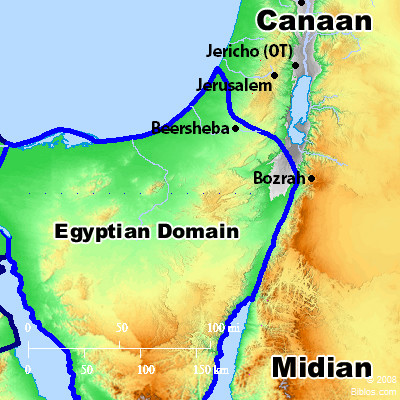Encyclopedia
MIDIAN; MIDIANITESmid'-i-an, mid'-i-an-its (midhyan, midhyanim; Madiam, Madienaioi):
1. The See d of Abraham to the Time of the Judges:
Midian was a son of Abraham by his concubine Keturah. To him were born 5 sons, Ephah, Epher, Hanoch, Abida and Eldaah (Genesis 25:2, 4 1 Chronicles 1:32 f). Bearing gifts from Abraham, he and his brothers, each with his own household, moved off from Isaac into "the east country" (Genesis 25:6). The first recorded incident in the history of the tribe is a defeat suffered "in the field of Moab" at the hands of Hadad, king of Edom. Of this nothing beyond the fact is known (Genesis 36:35 1 Chronicles 1:46). The Midianites next appear as merchantmen traveling from Gilead to Egypt, with "spicery and balm and myrrh," with no prejudice against a turn of slave-dealing (Genesis 37:25). Moses, on fleeing from Egypt, found refuge in the land of Midian, and became son-in-law of Jethro, the priest of Midian (Exodus 2:15, 21). In Midian Moses received his commission to Israel in Egypt (Exodus 4:19). A Midianite, familiar with the desert, acted as guide ("instead of eyes") to the children of Israel in their wilderness wanderings (Numbers 10:29). The friendly relations between Israel and Midian, which seem to have prevailed at first, had been ruptured, and we find the elders of Midian acting with those of Moab in calling Balaam to curse Israel (Numbers 22:4-7). Because of the grievous sin into which they had seduced Israel on the shrewd advice of Balaam, a war of vengeance was made against the Midianites in which five of their chiefs perished; the males were ruthlessly slain, and Balaam also was put to death (Numbers 25:15, 17; Numbers 31:2). We next hear of Midian as oppressing Israel for 7 years. Along with the Amalekites and the children of the East they swarmed across the Jordan, and their multitudinous beasts swept up the produce of the earth. Overwhelming disaster befell this horde at the onset of Gideon's chosen men. In the battle and pursuit "there fell a hundred and twenty thousand men that drew sword"; their kings, Zebah and Zalmunna, and their princes, Oreb and Zeeb, sharing the common fate (Judges 6; Judges 7; Judges 7 8). Echoes of this glorious victory-"the day of Midian"-are heard in later literature (Psalm 83:9 Isaiah 9:4; Isaiah 10:26 Habakkuk 3:7).
2. The Kenite Branch:
The Kenites appear to have been a branch of the Midianites. Jethro could hardly have attained the dignity of the priesthood in Midian had he been of alien blood (Judges 1:16). See KENITES. Again, the tribesmen are named indifferently Ishmaelites and Midianites (Genesis 37:25, 28, 36 Judges 8:22, 24). They must therefore have stood in close relations with the descendants of Hagar's son.
3. Modern Arabs:
The representations of Midian in Scripture are consistent with what we know of the immemorial ways of Arabian tribes, now engaged in pastoral pursuits, again as carriers of merchandise, and yet again as freebooters. Such tribes often roam through wide circles. They appear not to have practiced circumcision (Exodus 4:25), which is now practically universal among the Arabs. The men wore golden ornaments, as do the modern nomads (Judges 8:24).
4. Historical References:
The name of "Midian" is not found in Egyptian or Assyrian documents. Delitzsch (Wo lag das Paradies? 304) suggests that Ephah (Genesis 25:4) may be identical with Chayapa of the cuneiform inscriptions. If this is correct the references point to the existence of this Midianite tribe in the North of el-Chijaz in the times of Tiglath-pileser and Sargon (745-705 B.C.). Isaiah speaks of Midian and Ephah apparently as separate tribes, whose dromedaries bear gold and frankincense to Zion (60:6); but he gives no hint of the districts they occupied. The tribe of Ghifar, found in the neighborhood of Medina in Mohammed's day, Knobel would identify with Epher, another of Midian's sons.
5. Territory:
No boundaries can now be assigned to "the land of Midian." It included territory on the West as well as on the East of the Gulf of `Aqaba (Exodus 4:19). It lay between Edom and Paran (1 Kings 11:18). In the time of the Judges their district seems to have extended northward to the East of Gilead (8:10).
A trace of the ancient name is found in that of Madyah, a place mentioned by the Arabic geographers, with a plentiful supply of water, now called Maghair Sho`aib. It lies East of the Gulf of `Aqaba, some miles from the coast, almost opposite the point of the Sinaitic peninsula. The name Sho`aib, given by Mohammed to Jethro, may here be due to ancient Midianite tradition.
W. Ewing




